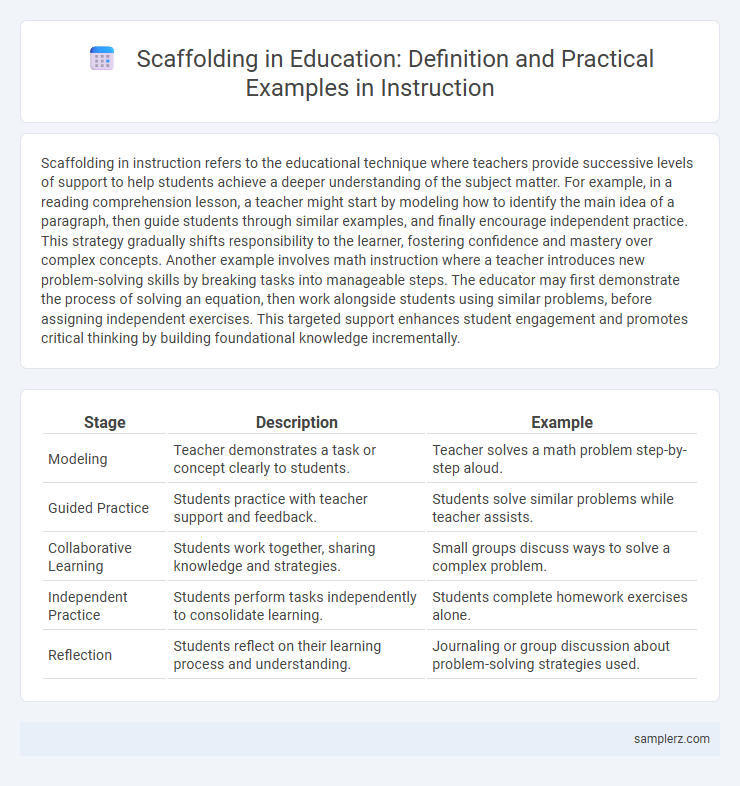Scaffolding in instruction refers to the educational technique where teachers provide successive levels of support to help students achieve a deeper understanding of the subject matter. For example, in a reading comprehension lesson, a teacher might start by modeling how to identify the main idea of a paragraph, then guide students through similar examples, and finally encourage independent practice. This strategy gradually shifts responsibility to the learner, fostering confidence and mastery over complex concepts. Another example involves math instruction where a teacher introduces new problem-solving skills by breaking tasks into manageable steps. The educator may first demonstrate the process of solving an equation, then work alongside students using similar problems, before assigning independent exercises. This targeted support enhances student engagement and promotes critical thinking by building foundational knowledge incrementally.
Table of Comparison
| Stage | Description | Example |
|---|---|---|
| Modeling | Teacher demonstrates a task or concept clearly to students. | Teacher solves a math problem step-by-step aloud. |
| Guided Practice | Students practice with teacher support and feedback. | Students solve similar problems while teacher assists. |
| Collaborative Learning | Students work together, sharing knowledge and strategies. | Small groups discuss ways to solve a complex problem. |
| Independent Practice | Students perform tasks independently to consolidate learning. | Students complete homework exercises alone. |
| Reflection | Students reflect on their learning process and understanding. | Journaling or group discussion about problem-solving strategies used. |
Introduction to Scaffolding in Education
Scaffolding in education involves providing structured support to students as they develop new skills or knowledge, gradually removing assistance as competence increases. An example includes breaking down complex tasks into manageable steps, offering guiding questions, or modeling processes before expecting independent completion. This instructional strategy enhances comprehension and promotes learner autonomy by aligning support with individual student needs.
Key Principles of Instructional Scaffolding
Instructional scaffolding involves providing tailored support based on students' current understanding, gradually fading assistance to promote independence and encouraging active learning through guided practice. Key principles include modeling tasks to demonstrate skills, structuring information in manageable chunks, and offering timely feedback to reinforce learning. This approach enhances comprehension and problem-solving abilities by aligning support with learners' evolving needs.
Gradual Release of Responsibility: A Scaffolding Framework
Gradual Release of Responsibility (GRR) is a scaffolding framework where teachers begin by modeling a task, then guide students through supported practice before encouraging independent work. This approach improves student comprehension and skill mastery by systematically shifting cognitive load from teacher to learner. Research by Pearson and Gallagher (1983) highlights GRR's effectiveness in fostering autonomy and confidence in diverse educational settings.
Real-Life Example: Scaffolding in Reading Comprehension
Scaffolding in reading comprehension can be seen when teachers use guided questioning to help students analyze a complex text, breaking it down into manageable parts that build understanding step-by-step. For example, educators often model how to identify the main idea and supporting details before asking students to summarize the passage independently. This incremental support fosters critical thinking and gradually develops students' ability to interpret challenging literature on their own.
Interactive Scaffolding: Collaborative Group Activities
Interactive scaffolding in education involves collaborative group activities where students engage in problem-solving tasks together, promoting peer-to-peer learning and critical thinking. Teachers facilitate by guiding discussions and providing targeted prompts, gradually reducing support as students build confidence and mastery. This method enhances communication skills, deepens conceptual understanding, and fosters independent learning within a socially interactive environment.
Technology-Based Scaffolding Tools in the Classroom
Technology-based scaffolding tools such as interactive whiteboards, educational apps, and adaptive learning software provide personalized support to students by adjusting difficulty levels based on individual progress. These tools enhance comprehension and engagement by offering immediate feedback and multimedia resources that cater to various learning styles. Integrating technology into instruction facilitates gradual independence, empowering learners to build skills and confidence in complex subject areas.
Differentiated Scaffolding for Diverse Learners
Differentiated scaffolding in instruction tailors support based on individual learner needs, such as using graphic organizers for visual learners and verbal prompts for auditory learners. Teachers adjust the level of guidance, gradually reducing assistance as students gain mastery over complex concepts. This strategic approach enhances understanding and engagement among diverse learners by aligning scaffolded supports with their unique strengths and challenges.
Scaffolding in Problem-Based Learning Environments
Scaffolding in problem-based learning environments involves providing students with structured support such as guiding questions, step-by-step frameworks, and timely feedback to facilitate critical thinking and problem-solving skills. Educators gradually reduce assistance as learners develop independence, enabling them to tackle complex real-world problems confidently. Research highlights that effective scaffolding enhances student engagement and promotes deeper understanding in collaborative, inquiry-driven educational settings.
Teacher’s Role in Effective Scaffolding
The teacher's role in effective scaffolding involves providing tailored support that gradually shifts responsibility to the student as competence increases. This includes modeling problem-solving strategies, giving timely feedback, and adjusting assistance based on the learner's progress. Effective scaffolding enhances student engagement, promotes critical thinking, and fosters independent learning skills.
Assessing Student Progress During Scaffolding
Assessing student progress during scaffolding involves ongoing formative assessments such as exit tickets, quizzes, and observational checklists to monitor understanding and identify areas needing support. Using tools like rubrics and self-assessment guides enables teachers to adjust the level of guidance according to individual student needs. Data-driven feedback helps scaffold instruction effectively, promoting mastery of skills and concept retention.

example of scaffolding in instruction Infographic
 samplerz.com
samplerz.com